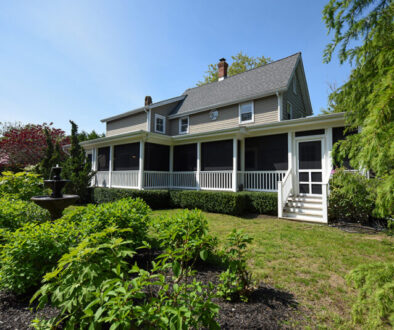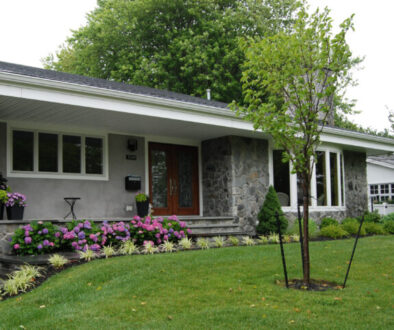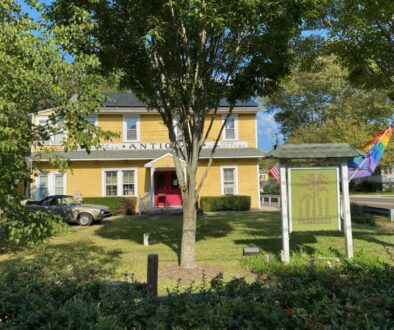Paige Cunningham

Paige Cunningham and I decided to meet on the Washington Street Mall one late afternoon just after she left work. As she walked toward the bench where I was seated, I was preparing to compliment her on the brightly colored jean jacket she was wearing—a jacket that I pretty much assumed she had carefully designed herself. As she approached, it was clear to me that what I thought to be a smartly decorated jacket doubled as her artist’s smock which had been happily smudged and splashed with a full spectrum of joy. I could only imagine that to the residents of a local nursing home where she teaches art, she beats out any favorite teacher any of them could name from their childhood.
(Accessibility note: Interview questions are headings.)
How long have you been an artist?
It depends how you define “artist.” Since I was a kid, I doodled all the time. I was a really bad test taker. The only reason I passed middle school is because all my extra credit was art related. In that respect, I was an artist. I feel we’re all artists. If you’re a gardener, your palate changes every day. I didn’t do much art in my 20s at college because I was busy working three jobs. But I really didn’t get into art until I moved here in 2001. The Center for Community Arts needed help with their fundraisers, and I found out they needed teachers and that’s what I started doing.
I know one of your mediums is felt. I’ve seen your different felt sculptures and figures.
I use sheep’s wool. They call it roving. It’s called that because it’s the wool just before it’s spun into yarn. You can create whatever you want with it.
Tell me about sharing creativity with the elderly.
One of my two favorite jobs that I have right now is at the nursing home in North Cape May. My friend Barbara Hoepp was a social worker and told me what they do in the activities department. I knew I needed to go there. I started helping them with arts and crafts and on field trips. Eventually I was asked if I wanted to teach art classes. I still teach dancing and yoga, but one day a week is art.
What type of art do they learn?
I do everything I can with them. Whatever they consider art to be. Art is life, whether it is math, gardening, raising kids—you take a blank something and create something magical.
Is that what you meant when you said we are all artists?
Yes, and the problem is that we were all told somewhere in life, perhaps grade school or middle school, that we were not creative. Our earliest stage of childhood has us creating very abstractly—a kid picks up a crayon and scribbles. But as we get older, we want things to be more realistic. That’s the age when ego steps in and you compare yourself with others or feel you’re not doing it well enough. But I tell people, that you don’t have to draw a straight line, you just have to do your line. Just do your thing and give it your voice. If you do art from your heart, you’re good.
How do you convince people in their twilight years that they really are creative?
You don’t have to. What surprises me the most about the people in the nursing home is that they are willing to do anything. I have seen people at 100 realize they are artists. There is a misconception that people in nursing homes can’t do anything. They are only there because they need medical help. We all want to be loved and to be connected with others. The 16 people I had today were not there because of what we were making, but to be with one another and work together. And then at the end they realize, “Oh, wow. Look what we did!”
Can you give me a specific example of how someone learning they are creative is healing for them?
I had a resident who was in a laid-back wheelchair, could hardly see and only had mobility in one arm. She still came out every time I did art because she said, “I don’t feel the pain I’m in. I don’t feel like I’m not needed. It gets me out of my head and lets me be productive.” And that is something I hear from many residents.
Do many residents in these nursing homes feel that sort of negativity about themselves?
They don’t always have a choice. They have to depend on an aide or a nurse to get them out of bed or to take a shower. It’s very challenging for anyone to not be negative when they must depend on others for so much. Doing art gives them a choice. They have chosen to come and join the group and they can choose what they want to create. It helps get them out among others.
Do all artistic mediums have the same positive effect on the elderly?
The biggest thing is music! A person could be in a wheelchair in the Alzheimer’s wing and not capable of anything, but the minute they come out for music, you see their foot tapping, you see a smile on their face, and they start becoming active and responsive again. Music is key to them.
Why do you think the auditory senses are able to spark that more than visual stimulation?
Well, for some it might be visual if they can see well. But with the auditory sense, there is something about the way music gets in our soul. Since we were all small children, our moms played music for us and sang to us. Somehow, we’re tuned into that.
You mentioned a minute ago about teaching them yoga. Tell me about that.
Well, we don’t do headstands (laughing). We do chair yoga. I teach them breathing exercises, hand exercises, lions’ roars to get their lungs going. We do very simple flexing to get them ready for the day.
What’s the hardest part of working with the elderly?
The hardest part is when they die. After 21 years I still haven’t gotten used to it. They are my family, they really are. And I become close with their families. There are some residents I have been with for 10 years—that’s a long time to be with someone when you’re helping them and sharing with them. I have to just let myself cry when it happens. Many of us will attend their funerals.
Does the joy you see in them outweigh the sadness you experience when they pass away?
Yes. They are there simply because they need some help. They love to have fun and create and be silly. One of their favorite games is having water gun fights. I want them all to live the best life they can while they can.
How do their families respond to the work you do?
Countless times their relatives will come and say to me, “How do you do this?” I tell them that I haven’t known them previously. The families remember these people from their childhoods, and they see the state they are in now and it worries and saddens them. I only know them as they are when they first become residents. I embrace that and I celebrate that. So, in the nursing home we all try to do as much as we can with them.
I know that daily routines and programs during the pandemic were disrupted but I’d like you to tell me what stood out in your mind when things got back to normal.
Well, art and music must be important because when they finally allowed two people in who weren’t medical staff, they chose the pastor or the priest and then they chose me. That told me that they need the magic of art for their soul just as much as spirituality.
Can you talk about the connection between spirituality and art?
When I am in nature, it’s like my church. I do go to church, too, at Our Lady Star of the Sea. I love the feeling I get when I am sitting in there, and I feel that same thing sitting in nature too. There is a certain zone in which you can spend time and not even realize the time that passes. If you are doing something that bridges your mind with your soul, everything else just falls away. You’ll be creating in that zone and barely watching what’s happening in front of you on your paper or canvas—colors are moving, and things are appearing. It’s meditative. The elderly experience that same connection between art and the spiritual when they can forget their loneliness or their pain.
Is much of your inspiration from the natural world?
(Paige points at the shadow of a tree on the side of a building across from us) You see the shadow of that tree? I’m sitting here looking at that and I’m enthralled with it. We all see things differently. If I don’t draw every day, I go through withdrawal.
In the book The Artist’s Way, the author [Julia Cameron] talks about the creative partnership between an artist and God. Do you feel you are alone when you create, or do you feel it’s a partnership?
Definitely a partnership! Here’s an example: I wrote a book called The Friendship Diary; it was my Covid project. I would be in my friend’s pool and there might be a turtle in there and then out of nowhere I would have a poem pop into my head. I got out of the pool, typed it into my phone and the moment was gone. Now, English was my worst subject. Writing is not my thing. But every day for a year that was happening, and when I finished the book nothing else ever came to me that needed me to write it down. So, my book of poems was not me, I feel it was channeled through me from something or someone else. Art can be like that too. I can look at something after creating it and say, “Wow, did I really create that?”
We’ve spoken about the challenges of being with the elderly. Tell me one of the many rewards.
Being connected with them. I never thought I’d make such a deep family connection with them. Another reward is seeing the family members come in and see the art hanging on the wall that their loved one created. They’ll ask with surprise, “Wow, they really did that?” And another reward is the wisdom and the stories and the love that the residents share with me. It’s a privilege to be with them. Life is about connection. Love is a connection and that’s what is made there.
With whom does the responsibility lie to promote the art community in Cape May? The artists themselves? The businesses? The city?
I think it’s a combination of all those things. Regarding the City of Cape May, perhaps they could focus on art in their ads. For instance, the way they would promote their beaches or history or fine dining, they could put out some ads about the art that is created here. In terms of the artists themselves, the hardest thing for an artist seems to be self-promotion. I’ve talked to so many artists a million times about promotion. We are the worst at doing that. It’s hard for us because we are putting our soul out there. Putting our art out there is very vulnerable for us.
The one theme I have heard you talk about is that of the creation process being equally as important as the finished work.
Art always connects us when we express ourselves through the heart. In this way, people feel loved and seen and heard. It doesn’t matter what we create, it’s the connection we make during the process.



